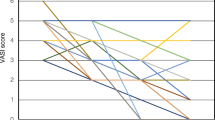Abstract
This study was initiated to evaluate the safety and effectiveness of intraepidermal injection of dissociated epidermal cells into the lesions of stable vitiligo patients. Autologous dissociated epidermal cell suspensions were injected intraepidermally into 10 stable vitiligo patients. None of the patients received adjuvant therapy. The response was evaluated as: marked (76–100%), moderate (51–75%), mild (26–50%) and minimal repigmentation (0–25%). Transmission electron microscopy was used to evaluate the transplanted cells and immunohistochemical staining with HMB-45 was performed to assess the repigmentation in vivo. In all cases, repigmentation started during the 4-week period after transplantation. Six months after transplantation, a marked repigmentation in four (40%), moderate repigmentation in two (20%) and mild repigmentation in two (20%) patients were observed. Two (20%) patients with white patches on their lids showed minimal repigmentation. No side effects were observed in any patients. Interestingly, repigmentation of gray hair in one patient, 4 months post transplantation was observed. Analysis of the ultrastructure of transplanted cells showed 1.5% of the cells had melanocyte morphology. HMB-45 positive cells were observed after cell transplantation. This method is an effective, simple and safe therapeutic option for stable vitiligo lesions.



Similar content being viewed by others
References
Akama K, Tatsuno R, Otsu M et al (2008) Proteomic identification of differentially expressed genes in mouse neural stem cells and neurons differentiated from embryonic stem cells in vitro. Biochim Biophys Acta 1784:773–782
Alonso L, Fuchs E (2003) Stem cells of the skin epithelium. Proc Natl Acad Sci USA 100(Suppl 1):11830–11835
Chen YF, Chang JS, Yang PY, Hung CM, Huang MH, Hu DN (2000) Transplant of cultured autologous pure melanocytes after laser-abrasion for the treatment of segmental vitiligo. J Dermatol 27:434–439
Czajkowski R (2004) Comparison of melanocytes transplantation methods for the treatment of vitiligo. Dermatol Surg 30:1400–1405
Czajkowski R, Placek W, Drewa T, Olszewska-Slonina D, Sir J, Kowaliszyn B, Weiss M (2006) Establishing melanocyte cultures in a serum-free system for transplantation in vitiligo patients. Med Sci Monit 12:CR63–CR69
Dell’anna ML, Picardo M (2006) A review and a new hypothesis for non-immunological pathogenetic mechanisms in vitiligo. Pigment Cell Res 19:406–411
Fitzpatrick TB, Eisen AZ, Wolff K, Freedberg IM, Austen K (1993) Dermatology in general medicine. McGraw-Hill, NewYork
Gauthier Y, Surleve-Bazeille JE (1992) Autologous grafting with noncultured melanocytes: a simplified method for treatment of depigmented lesions. J Am Acad Dermatol 26:191–194
Hartmann A, Broecker EB, Hamm H (2008) Repigmentation of skin and hairs in stable vitiligo by transplantation of autologous melanocytes in fibrin suspension. J Eur Acad Dermatol Venereol 22:624–626
James W, Berger TG, Elston DM (2006) Andrews diseases of the skin clinical dermatology. Saunders, Philadelphia
Le Poole IC, van den Wijngaard RM, Westerhof W, Das PK (1997) Tenascin is overexpressed in vitiligo lesional skin and inhibits melanocyte adhesion. Br J Dermatol 137:171–178
Le Poole IC, van den Wijngaard RM, Westerhof W, Dutrieux RP, Das PK (1993) Presence or absence of melanocytes in vitiligo lesions: an immunohistochemical investigation. J Invest Dermatol 100:816–822
Olsson MJ, Juhlin L (1998) Leucoderma treated by transplantation of a basal cell layer enriched suspension. Br J Dermatol 138:644–648
Ongenae K, Van Geel N, Naeyaert JM (2003) Evidence for an autoimmune pathogenesis of vitiligo. Pigment Cell Res 16:90–100
Ortonne JP, Bose SK (1993) Vitiligo: where do we stand? Pigment Cell Res 6:61–72
Passeron T, Ortonne JP (2005) Physiopathology and genetics of vitiligo. J Autoimmun 25(Suppl):63–68
Pianigiani E, Andreassi A, Andreassi L (2005) Autografts and cultured epidermis in the treatment of vitiligo. Clin Dermatol 23:424–429
Ramaiah A, Puri N, Mojamdar M (1989) Etiology of vitiligo. A new hypothesis. Acta Derm Venereol 69:323–326
Schallreuter KU, Chavan B, Rokos H, Hibberts N, Panske A, Wood JM (2005) Decreased phenylalanine uptake and turnover in patients with vitiligo. Mol Genet Metab 86(Suppl 1):S27–S33
Spritz RA (2006) The genetics of generalized vitiligo and associated autoimmune diseases. J Dermatol Sci 41:3–10
van Geel N, Ongenae K, De Mil M, Naeyaert JM (2001) Modified technique of autologous noncultured epidermal cell transplantation for repigmenting vitiligo: a pilot study. Dermatol Surg 27:873–876
Zhang XJ, Chen JJ, Liu JB (2005) The genetic concept of vitiligo. J Dermatol Sci 39:137–146
Acknowledgments
We are grateful to Mr. Piryaei, for technical support. This study was supported by a grant from Royan Institute.
Conflict of interest statement
None.
Author information
Authors and Affiliations
Corresponding authors
Additional information
The authors L. Khodadadi and S. Shafieyan contributed equally to this study.
Rights and permissions
About this article
Cite this article
Khodadadi, L., Shafieyan, S., Sotoudeh, M. et al. Intraepidermal injection of dissociated epidermal cell suspension improves vitiligo. Arch Dermatol Res 302, 593–599 (2010). https://doi.org/10.1007/s00403-010-1034-7
Received:
Revised:
Accepted:
Published:
Issue Date:
DOI: https://doi.org/10.1007/s00403-010-1034-7




